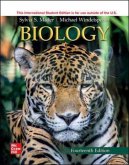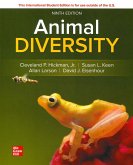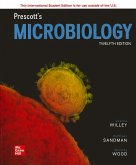- Broschiertes Buch
- Merkliste
- Auf die Merkliste
- Bewerten Bewerten
- Teilen
- Produkt teilen
- Produkterinnerung
- Produkterinnerung
Mader's Inquiry into Life represents one of the cornerstones of introductory biology education. Inquiry into Life was founded on the belief that teaching science from a human perspective, coupled with human applications, would make the material more relevant to the student.
Andere Kunden interessierten sich auch für
![Biology ISE Biology ISE]() Sylvia MaderBiology ISE74,99 €
Sylvia MaderBiology ISE74,99 €![ISE Animal Diversity ISE Animal Diversity]() Hickman, Jr., ClevelandISE Animal Diversity84,99 €
Hickman, Jr., ClevelandISE Animal Diversity84,99 €![ISE Vertebrates: Comparative Anatomy, Function, Evolution ISE Vertebrates: Comparative Anatomy, Function, Evolution]() Kenneth KardongISE Vertebrates: Comparative Anatomy, Function, Evolution84,99 €
Kenneth KardongISE Vertebrates: Comparative Anatomy, Function, Evolution84,99 €![ISE Discrete Mathematics and Its Applications ISE Discrete Mathematics and Its Applications]() Kenneth RosenISE Discrete Mathematics and Its Applications102,99 €
Kenneth RosenISE Discrete Mathematics and Its Applications102,99 €![Essentials of Life-Span Development: 2024 Release ISE Essentials of Life-Span Development: 2024 Release ISE]() John SantrockEssentials of Life-Span Development: 2024 Release ISE64,99 €
John SantrockEssentials of Life-Span Development: 2024 Release ISE64,99 €![Prescott's Microbiology ISE Prescott's Microbiology ISE]() Joanne WilleyPrescott's Microbiology ISE62,99 €
Joanne WilleyPrescott's Microbiology ISE62,99 €![ISE Modern Compressible Flow: With Historical Perspective ISE Modern Compressible Flow: With Historical Perspective]() John AndersonISE Modern Compressible Flow: With Historical Perspective84,99 €
John AndersonISE Modern Compressible Flow: With Historical Perspective84,99 €-
-
-
Mader's Inquiry into Life represents one of the cornerstones of introductory biology education. Inquiry into Life was founded on the belief that teaching science from a human perspective, coupled with human applications, would make the material more relevant to the student.
Hinweis: Dieser Artikel kann nur an eine deutsche Lieferadresse ausgeliefert werden.
Hinweis: Dieser Artikel kann nur an eine deutsche Lieferadresse ausgeliefert werden.
Produktdetails
- Produktdetails
- Verlag: McGraw-Hill Education
- 17 ed
- Seitenzahl: 802
- Erscheinungstermin: 20. Mai 2022
- Englisch
- Abmessung: 229mm x 277mm x 28mm
- Gewicht: 1424g
- ISBN-13: 9781265140601
- ISBN-10: 126514060X
- Artikelnr.: 63201428
- Herstellerkennzeichnung
- Libri GmbH
- Europaallee 1
- 36244 Bad Hersfeld
- gpsr@libri.de
- Verlag: McGraw-Hill Education
- 17 ed
- Seitenzahl: 802
- Erscheinungstermin: 20. Mai 2022
- Englisch
- Abmessung: 229mm x 277mm x 28mm
- Gewicht: 1424g
- ISBN-13: 9781265140601
- ISBN-10: 126514060X
- Artikelnr.: 63201428
- Herstellerkennzeichnung
- Libri GmbH
- Europaallee 1
- 36244 Bad Hersfeld
- gpsr@libri.de
Sylvia S. Mader has authored several nationally recognized biology texts published by McGraw-Hill. Educated at Bryn Mawr College, Harvard University, Tufts University, and Nova Southeastern University, she holds degrees in both Biology and Education. Over the years she has taught at University of Massachusetts, Lowell; Massachusetts Bay Community College; Suffolk University; and Nathan Mayhew Seminars. Her ability to reach out to science-shy students led to the writing of her first text, Inquiry into Life, which is now in its fifteenth edition. Highly acclaimed for her crisp and entertaining writing style, her books have become models for others who write in the field of biology.
Brief Contents1. Biology: The Study of Life;
Unit 1 Cell Biology;
2. The Molecules of Cells
3. Cell Structure and Function;
4. Membrane Structure and Function
5. Cell Division
6. Metabolism: Energy and Enzymes
7. Cellular Respiration
Unit 2 Plant Biology
8. Photosynthesis
9. Plant Organization and Function
10. Plant Reproduction, Growth, and Response;
Unit 3 Maintenance of the Human Body
11. Human Organization
12. Cardiovascular System
13. Lymphatic and Immune Systems
14. Digestive System and Nutrition
15. Respiratory System
16. Urinary System and Excretion
Unit 4 Integration and Control of the Human Body
17. Nervous System
18. Senses
19. Musculoskeletal System
20. Endocrine System
Unit 5 Continuance of the Species
21. Reproductive System
22. Development and Aging
23. Patterns of Gene Inheritance
24. Chromosomal Basis of Inheritance
25. DNA Structure and Gene Expression
26. Biotechnology and Genomics
Unit 6 Evolution and Diversity;
27. Evolution of Life
28. Microbiology
29. Protists and Fungi
30. Plants
31. Animals: The Invertebrates
32. Animals: Chordates and Vertebrates
Unit 7 Behavior and Ecology
33. Behavioral Ecology
34. Population and Community Ecology
35. Nature of Ecosystems
36. Major Ecosystems of the Biosphere
37. Conservation Biology
Unit 1 Cell Biology;
2. The Molecules of Cells
3. Cell Structure and Function;
4. Membrane Structure and Function
5. Cell Division
6. Metabolism: Energy and Enzymes
7. Cellular Respiration
Unit 2 Plant Biology
8. Photosynthesis
9. Plant Organization and Function
10. Plant Reproduction, Growth, and Response;
Unit 3 Maintenance of the Human Body
11. Human Organization
12. Cardiovascular System
13. Lymphatic and Immune Systems
14. Digestive System and Nutrition
15. Respiratory System
16. Urinary System and Excretion
Unit 4 Integration and Control of the Human Body
17. Nervous System
18. Senses
19. Musculoskeletal System
20. Endocrine System
Unit 5 Continuance of the Species
21. Reproductive System
22. Development and Aging
23. Patterns of Gene Inheritance
24. Chromosomal Basis of Inheritance
25. DNA Structure and Gene Expression
26. Biotechnology and Genomics
Unit 6 Evolution and Diversity;
27. Evolution of Life
28. Microbiology
29. Protists and Fungi
30. Plants
31. Animals: The Invertebrates
32. Animals: Chordates and Vertebrates
Unit 7 Behavior and Ecology
33. Behavioral Ecology
34. Population and Community Ecology
35. Nature of Ecosystems
36. Major Ecosystems of the Biosphere
37. Conservation Biology
Brief Contents1. Biology: The Study of Life;
Unit 1 Cell Biology;
2. The Molecules of Cells
3. Cell Structure and Function;
4. Membrane Structure and Function
5. Cell Division
6. Metabolism: Energy and Enzymes
7. Cellular Respiration
Unit 2 Plant Biology
8. Photosynthesis
9. Plant Organization and Function
10. Plant Reproduction, Growth, and Response;
Unit 3 Maintenance of the Human Body
11. Human Organization
12. Cardiovascular System
13. Lymphatic and Immune Systems
14. Digestive System and Nutrition
15. Respiratory System
16. Urinary System and Excretion
Unit 4 Integration and Control of the Human Body
17. Nervous System
18. Senses
19. Musculoskeletal System
20. Endocrine System
Unit 5 Continuance of the Species
21. Reproductive System
22. Development and Aging
23. Patterns of Gene Inheritance
24. Chromosomal Basis of Inheritance
25. DNA Structure and Gene Expression
26. Biotechnology and Genomics
Unit 6 Evolution and Diversity;
27. Evolution of Life
28. Microbiology
29. Protists and Fungi
30. Plants
31. Animals: The Invertebrates
32. Animals: Chordates and Vertebrates
Unit 7 Behavior and Ecology
33. Behavioral Ecology
34. Population and Community Ecology
35. Nature of Ecosystems
36. Major Ecosystems of the Biosphere
37. Conservation Biology
Unit 1 Cell Biology;
2. The Molecules of Cells
3. Cell Structure and Function;
4. Membrane Structure and Function
5. Cell Division
6. Metabolism: Energy and Enzymes
7. Cellular Respiration
Unit 2 Plant Biology
8. Photosynthesis
9. Plant Organization and Function
10. Plant Reproduction, Growth, and Response;
Unit 3 Maintenance of the Human Body
11. Human Organization
12. Cardiovascular System
13. Lymphatic and Immune Systems
14. Digestive System and Nutrition
15. Respiratory System
16. Urinary System and Excretion
Unit 4 Integration and Control of the Human Body
17. Nervous System
18. Senses
19. Musculoskeletal System
20. Endocrine System
Unit 5 Continuance of the Species
21. Reproductive System
22. Development and Aging
23. Patterns of Gene Inheritance
24. Chromosomal Basis of Inheritance
25. DNA Structure and Gene Expression
26. Biotechnology and Genomics
Unit 6 Evolution and Diversity;
27. Evolution of Life
28. Microbiology
29. Protists and Fungi
30. Plants
31. Animals: The Invertebrates
32. Animals: Chordates and Vertebrates
Unit 7 Behavior and Ecology
33. Behavioral Ecology
34. Population and Community Ecology
35. Nature of Ecosystems
36. Major Ecosystems of the Biosphere
37. Conservation Biology








